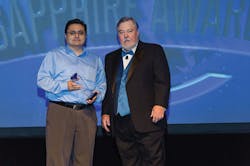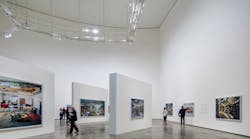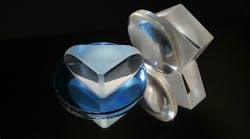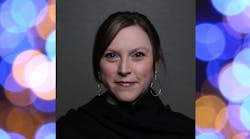On the evening of Feb. 28, 2019, LEDs Magazine hosted a Gala celebrating our fifth annual Sapphire Awards winners, including Illumineer of the Year Tigran Galstian of LensVector and Université Laval (Québec, Canada). The 2019 Sapphire Awards produced a long list of extremely innovative products ranging from packaged LEDs to smart lighting systems.
To culminate the evening, we presented our Illumineer of the Year award that recognizes an individual or small team that has developed truly game-changing technology in the solid-state lighting (SSL) field, and certainly the LensVector optics with dynamic focal point qualify. We have since had a chance to interview Galstian to learn more about the origins of his work and how it might be applied in new ways that aren’t immediately evident.
LEDs Magazine: Congratulations on winning our Sapphire Illumineer of the Year award. We had perhaps our most competitive set of nominees for Illumineer in the history of the program, and the judging panel, along with the public votes, clearly valued your work in optics and liquid-crystal technology. What were your thoughts going into the Gala with an outstanding LED development team and circadian lighting experts also nominated?Tigran Galstian: First of all, being considered alongside Jy Bhardwaj and Martin Moore-Ede was quite an honor. Their contributions to the industry and advancement of LED and lighting technology are tremendous. Though I believe that the work with my team at Université Laval and with LensVector is already having an impact, I was truly surprised by the decision of judges and industry participants.
LEDs: We understand that optics, or lenses for lighting, were not the initial target of your research into liquid-crystal technology. Can you tell us briefly what inspired you to pursue the original technology at the start of your work, and where you saw that technology being used and deployed?
Galstian: Indeed, we initially developed composite liquid-crystal materials in the photonics center (COPL) of Université Laval for liquid-crystal displays (LCDs), but we also discovered that we could make adaptive lenses by using our approach. We were so excited about the potential of the lens that we founded LensVector to commercialize these lenses — first for miniature cameras (imaging) and ophthalmology (vision), and ultimately for LED-based SSL where the ability to change beam shape is so important.
LEDs: What led you to consider the liquid-crystal technology as a good match for lighting applications and specifically as symbiotic with LED-based SSL applications?
Galstian: As we considered the potential for the liquid-crystal technology, it didn’t take too many conversations with people in the lighting industry to discover that there were challenges to be addressed, and the fit with solid-state light sources, like LED and “laser” (diode laser-pumped phosphor), was excellent. Our technology works best with small, highly efficient modules that can be used to generate narrow original light beams. Narrow light beams are best because our technology increases the light divergence by means of electrically activated liquid-crystal lenses. The smaller the light beam diameter of the source, the smaller are our lenses, lowering the cost and size of the resulting light fixture. The need to swap light sources to effect a beam change is a thing of the past. Dynamic beam shaping is a core capability required to create far more universal and valuable lighting solutions.
LEDs: We continue to find parallels in the LED lighting space where technologies that had played a role in electronics, IT, communications, or other tech sectors are finding a place in the SSL world — starting with the LED itself. Have you thought about those synergies, and did they play into your decision to focus on general lighting applications coincident with the move of that sector to LED sources?
Galstian: It is not unusual to leverage a technology developed for one application or industry to enable new applications in another industry. Our product benefits significantly from the development of LCDs as well as from the infrastructure that exists to produce such devices. To enter the lighting industry requires the ability to scale, produce reliably and with high quality and consistency. We leverage LCD production lines designed to produce low-cost, high-quality, and highly reliable display panels to manufacture our lenses. It would be difficult to take an exotic technology and apply it in a huge market such as lighting if the process and manufacturing had to be developed from scratch.
LEDs: What synergies do you see in LEDs and your dynamically-controllable optics?
Galstian: We see many parallels with SSL like LEDs. Light-emitting diodes reinforce the natural microscopic “electron-photon” loop — direct control of light by electrons. LensVector’s technology brings the light’s dynamic manipulation from the macro world (dominated by ground or molded optics) to the direct control of light by molecules. We call it molecular optics and we think that it’s a paradigm shift!
LEDs: We can see advantages for your dynamic beam control ranging from dynamic scene setting to elimination of maintenance tasks in re-aligning directional lighting to elimination of mechanical systems. If you had to choose one characteristic of a LensVector-based system that would be most responsible for future success, what is that characteristic and why is it paramount?
Galstian: The shape of light is a fundamental property of light that affects human perception of space and time. It’s as important as color and intensity. It’s hard to know today which application area might be most successful. Retail, architainment, and museum applications are certainly leading candidates, but as we make advances in human-centric lighting options, there will be new uses we haven’t yet considered. I think that our technology offers newfound agility to lighting and will allow various adaptive photonic solutions to be compelling tools in the future. Ultimately, the ability to dynamically, simply, and affordably change the shape of light will have economic and quality of life benefits. As my co-founder, Tom Killick, keeps saying, “We just need to put this technology into the hands of customers; they will decide how best to use it.”
LEDs: What are the limits of your technology in terms of minimum and maximum beam size?
Galstian: Our current products can shape initial beam angles of less than 5° and expand the light to more than 50°. Not many applications need this wide of a range. We have product lines that start at a wider angle that are less costly to produce, to better fit different market segments.
LEDs: Is there potential for controlling more than just the focal point and perhaps delivering different geometries beyond a circle? And if so, could that extend to some more-complex images with perhaps boundaries that are not smooth?
Galstian: This is probably the most common question we get from the lighting industry, and the answer is yes, we can do more than increase the beam size. It is possible to change its form, such as going from circular to linear or rectangular, and even to generate flat-top light distribution from a Gaussian-type distribution. We’ve done this in the lab and foresee a future where these capabilities are market ready. Our current development activities, though, are focused on bringing our current symmetric dynamic beam-shaping devices to mass markets.
LEDs: Is there a potential to use your technology to control other aspects of light such as color point or output level, or something else we haven’t thought of?
Galstian: As we consider the “electron-photon” loop and molecular optics options, we can imagine the ability to control many characteristics of light including color, intensity, angle, and shape. Today, our objective is to get basic symmetric beam shaping established in the marketplace, drive the costs down by volume, and listen to the lighting industry [on] how to use new technologies before we decide what to try to deliver.
LEDs: Is the liquid-crystal technology ready for commercial deployment today, or will the lighting industry require additional refinement in terms of performance or cost? And as to cost, do the advantages of dynamic control already justify the cost of the technology for luminaire manufacturers and their customers?
Galstian: Commercial luminaires are available today from companies like Targetti, Forma lighting, Ledra, Specialty, and more are coming to market almost monthly. The ecosystem is also expanding with more LensVector-ready drivers, module options, like those from Eulum, and control connections like those in Casambi.
LEDs: Where else outside general illumination might LensVector technology be deployed? It seems like it might have automotive- or medical-lighting applicability, for example.
Galstian: The automobile is indeed an important area of application, but there are also exciting potential uses for medical, horticulture, mobile, and many other areas. Light is so universal that it’s hard not to imagine applications where control of the light is valuable.
LEDs: We certainly hope you appreciate the Illumineer of the Year recognition. Can you tell us what your first reaction was when your name was called at the Gala? And how do you feel after a month in possession of the Illumineer Sapphire trophy?
Galstian: Surprised and excited! A month later I remain very appreciative and anxious to see our products in the hands of customers and see their reactions.






